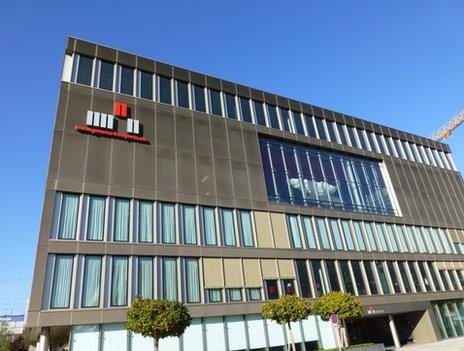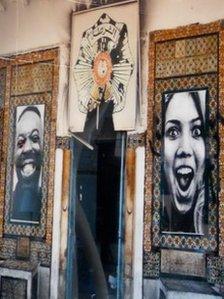Geneva's art storage boom in uncertain times
- Published

The Geneva free port is due to be extended next year
It may contain a treasure trove of Picassos but few have ever explored the riches in the Geneva free port art storage site.
In difficult economic times, investors are turning to more unusual commodities to protect their money. Gold may be a tried and tested safe haven, but in recent years fine art has been attracting increasing amounts of cash.
Last year global sales of art were estimated at more than $64bn (£40bn; 49bn euros) and traders watching the market say art has consistently outperformed equities in the years between 2001 and 2011.
The art boom has led to good times for institutions known as "free ports": bonded warehouses in which all sorts of commodities, from grain, to gold, to fine art, can be stored, and remain, while they are in storage, exempt from tax and customs duties.
The Geneva free port is, from the exterior, a rather unimpressive warehouse in an industrial area of the city.
Inside, it is said to house the largest collection of fine art anywhere in the world, although it is hard to find out exactly what is in there, as both the port's management and local customs officials refuse to divulge any information.
Rare loan
But Geneva art dealer Simon Studer can provide some clues.

The Simon Studer gallery displays works inside the free port
Today he has his own office and showroom inside the free port, specialising in modern and contemporary art. Twenty-five years ago however, he began his career with a job taking stock of the works stored at the free port.
"I was led to a storage place where paintings were stored," he explained, "and I had to go through Picasso works, so I was brought down in the morning and they locked me into the safe.
"At lunchtime I had to ring for them to take me out of the vaults. It was quite a strange environment because I was alone and I was surrounded by so many valuable artworks."
It is estimated there are at least 300 works by Picasso alone stored at the free port, many belonging to the reclusive Nahmad family, who have been buying and trading art as an investment for half a century.
The pieces they own are rarely seen in public although Zurich's museum of modern art did persuade the Nahmads to lend some of them for an exhibition in 2011, external.
One Nahmad family member has been quoted as saying that "Monet and Picasso are like Microsoft or Coca Cola", meaning that they are likely to be safe investments for a long time to come.
'An edge'

Simon Studer has been working in the free port for 25 years
That view, it seems, is increasingly shared by those hoping to protect their money from the perils of the global financial crisis. Jean-Rene Saillard works in Geneva for the British Fine Art Fund, an investment group devoted to buying art.
"We see art actually as a very good investment," he said. "It's a great way to diversify your portfolio, a good hedge against inflation. There are many reasons to consider art now as an investment."
The fund buys art ranging from the 16th to the 21st Century. Such a broad spectrum, said Mr Saillard, is a way of diversifying risk. But, like the contents of the free port, the fund's acquisitions are shrouded in secrecy. Asked what the latest purchase was, Mr Saillard became quiet.
"I can't tell you that," he said. "But I can tell you that we buy new works every week, and last week we had a very interesting transaction of a modern British painting."
The people who invest in the fund rarely, it seems, see the works of art they have put their money into. They certainly do not have them hanging on their walls. Instead, the pieces are safely stored at Geneva's free port.
"It's very secure and safe there," explained Mr Saillard.
'For show'
Not everyone who uses the free port, however, views art primarily as a valuable commodity.
Art dealer Simon Studer stores some of his collection of impressionist and modern art in the free port but says neither he nor his customers buy art as an investment.
"My clients hang the work they buy in their homes," he said. "They want it to be visible. They buy it because they are art lovers, not because they want to invest."
That is a view shared by Geneva resident and art fan Anne Shelton. A long time supporter of Geneva's art scene, and a collector herself, her home is full of original pieces, right down to special doorbell buzzers by Turner Prize-winner Douglas Gordon.
But, Ms Shelton admitted, she now owns "around 500" works of art and she simply does not have room for all of them. "They are unhappily sleeping, elsewhere," she laughed. "Because I buy too regularly."
Sleeping where? At the free port of course.
New ports
Nevertheless she views the free port not as a sign that art is being corrupted by money, but as a useful infrastructure to support Geneva's currently flourishing art scene.
"Geneva has finally got a real buzz going in contemporary art," she said. "I think lots of things have contributed to it, like the museum [of modern art, Mamco, external], and there are more and more galleries.
"Geneva is a city where there is a certain affluence - there's no doubt about it, that has to play an important part in it for sure - but we also have some fabulous artists, and that's got nothing to do with money."
Still, the current boom in art means free ports are booming too. Geneva is building a 10,000 sq m (108,000 sq ft) extension, due to open next year, and new free ports are springing up in Luxembourg, and in Singapore.
But, said Jean-Rene Saillard, Geneva remains the oldest, the biggest, and the one with the most art.
"It would be probably the best museum in the world if it was a museum," he added.
- Published14 March 2011
- Published18 December 2011